Sony DCR-DVD101, DCR-DVD201 Operating Instruction

[US] Instructions Operating
3-089-913-12 (1)
Digital
Video Camera
Recorder
Operating Instructions
Before operating the unit, please read this manual thoroughly, and retain it for future reference.
Owner’s Record
The model and serial numbers are located on the bottom. Record the serial number in the space provided below. Refer to these numbers whenever you call upon your Sony dealer regarding this product.
Model No. DCR-DVD |
|
|
Model No. AC- |
|
||
Serial No. |
|
|
|
Serial No. |
|
|
|
|
|
|
|
||
TM
SERIES
DCR-DVD101/DVD201
©2004 Sony Corporation

Welcome!
Congratulations on your purchase of this Sony Handycam. With your Handycam, you can capture life’s precious moments with superior picture and sound quality. Your Handycam is loaded with advanced features, but at the same time it is very easy to use. You will soon be producing home video that you can enjoy for years to come.
WARNING
To prevent fire or shock hazard, do not expose the unit to rain or moisture.
This symbol is intended to alert the user to the presence of uninsulated “dangerous voltage” within the product’s enclosure that may be of sufficient magnitude to constitute a risk of electric shock to persons.
This symbol is intended to alert the user to the presence of important operating and maintenance (servicing) instructions in the literature accompanying the appliance.
CAUTION
The use of optical instruments with this product will increase eye hazard. Use of controls or adjustments or performance of procedures other than those specified herein may result in hazardous radiation exposure.
Notice
If static electricity or electromagnetism causes data transfer to discontinue midway (fail), restart the application or disconnect and connect the USB cable again.
For customers in the U.S.A.
and CANADA
RECYCLING LITHIUM-ION BATTERIES
Lithium-Ion batteries are recyclable. You can help preserve our environment by returning
your used rechargeable batteries to the collection and recycling location nearest you.
For more information regarding recycling of rechargeable batteries, call toll free 1-800-822- 8837, or visit http://www.rbrc.org/
Caution: Do not handle damaged or leaking Lithium-Ion batteries.
For customers in the U.S.A.
If you have any questions about this product, you may call :
Sony Customer Information Center 1-800-222-SONY (7669)
The number below is for the FCC related matters only.
Regulatory Information
Declaration of Conformity
Trade Name: |
SONY |
Model No.: |
DCR-DVD101 |
Responsible Party:Sony Electronics Inc. |
|
Address: |
16450 W. Bernardo Dr, |
|
San Diego, CA 92127 |
|
U.S.A. |
Telephone No.: |
858-942-2230 |
This device complies with Part 15 of the FCC Rules. Operation is subject to the following two conditions: (1) This device may not cause harmful interference, and (2) this device must accept any interference received, including interference that may cause undesired operation.
2

Declaration of Conformity
Trade Name: |
SONY |
Model No.: |
DCR-DVD201 |
Responsible Party:Sony Electronics Inc. |
|
Address: |
16450 W. Bernardo Dr, |
|
San Diego, CA 92127 |
|
U.S.A. |
Telephone No.: |
858-942-2230 |
This device complies with Part 15 of the FCC Rules. Operation is subject to the following two conditions: (1) This device may not cause harmful interference, and (2) this device must accept any interference received, including interference that may cause undesired operation.
CAUTION
You are cautioned that any changes or modifications not expressly approved in this manual could void your authority to operate this equipment.
Note:
This equipment has been tested and found to comply with the limits for a Class B digital device, pursuant to Part 15 of the FCC Rules. These limits are designed to provide reasonable protection against harmful interference in a residential installation. This equipment generates, uses, and can radiate radio frequency energy and, if not installed and used in accordance with the instructions, may cause harmful interference to radio communications. However, there is no guarantee that interference will not occur in a particular installation. If this equipment does cause harmful interference to radio or television reception, which can be determined by turning the equipment off and on, the user is encouraged to try to correct the interference by one or more of the following measures:
—Reorient or relocate the receiving antenna.
—Increase the separation between the equipment and receiver.
—Connect the equipment into an outlet on a circuit different from that to which the receiver is connected.
—Consult the dealer or an experienced radio/
TV technician for help.
The supplied interface cable must be used with the equipment in order to comply with the limits for a digital device pursuant to Subpart B of Part 15 of FCC Rules.
Certain countries or regions may regulate disposal of the battery used to power this product. Please consult with your local authority.
Started Getting
3
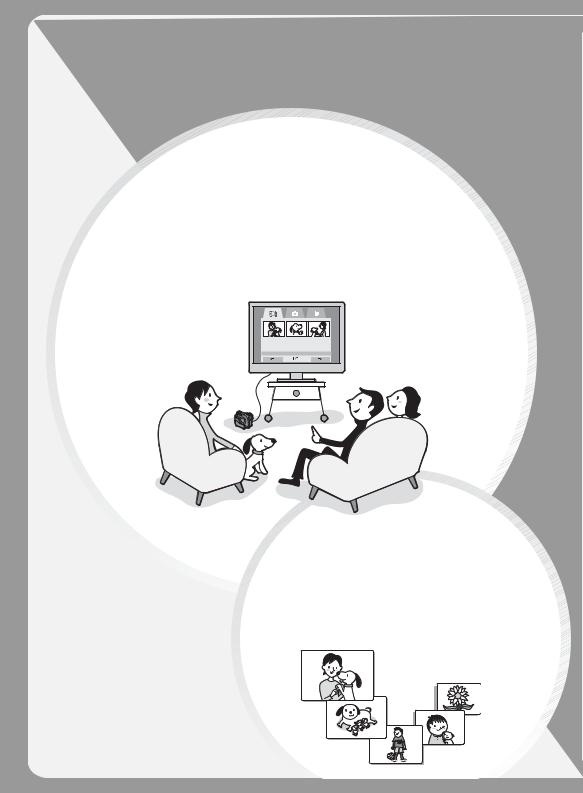
Read this first
What you can do with your
DVD Handycam
Your DVD Handycam uses DVD-R and DVD-RW as a recording media.
You can enjoy your DVD Handycam in ways that are new and different from those of a tape media-based camcorder. Read the next few pages to find out how.
You can find a scene quickly using a Visual Index display.
The Visual Index display shows thumbnails of movies and still images recorded on the disc in your DVD Handycam. You can find the desired scene quickly using this convenient index.
You can play back still images, one after another.
You can play back still images one after another on your DVD Handycam. You can also enjoy the playback of still images continuously on a DVD player if you finalize the disc.
4

You can play back a disc recorded with your DVD Handycam on your DVD player.
You can play back a disc recorded with your DVD Handycam on DVD players that can play back DVD-R/DVD-RW.
You can edit and copy a disc easily by connecting your DVD Handycam to your computer.
You can edit and copy a disc easily on your computer using the supplied ImageMixer Ver.1.5 for Sony DVD Handycam software. It also enables you to produce your own original DVD disc.
first this Read
5

What is the difference between DVD-R and DVD-RW?
Two types of discs are available and they are different in the following ways.
Which disc |
How can I |
can I use? |
choose |
|
between these |
|
two discs? |
8cm DVD-Rs and 8cm DVD-RWs are available.
The number of recordable times is different for the two discs. Choose the one that meets your needs.
8cm DVD-R
You can use the following discs:
•DMR30 (single-sided disc)
•DMR60DS (double-sided disc)
8cm DVD-RW
You can use the following discs:
•DMW30 (single-sided disc)
•DMW60DS (double-sided disc)
Discs other than these two types cannot be used in your DVD Handycam.
Examples of incompatible discs
• 12cm DVD-R
• 12cm DVD-RW
• DVD+R
• DVD-RAM
• DVD+RW
• DVD-ROM
• CD-R
• CD-RW
6
DVD-Rs can be recorded only once.
They are suitable for long-term records and for making a backup copies.
Recorded in VIDEO mode.
DVD-RWs can be overwritten repeatedly.
They are suitable for source gathering and temporary recordings.
You can choose VIDEO mode or VR mode to make your recordings.

What kind of player can I use for playback?
You can play back a disc you have recorded on your DVD Handycam on other players by finalizing the disc (see page 64).
The following list shows examples of players that can play back a disc recorded by your DVD Handycam. However, playback compatibility is not guaranteed with all players.*1
DVD-R
(VIDEO mode only)
Players compatible
with the DVD Video format.
DVD player/ |
Computer with a |
DVD recorder |
DVD drive installed |
first this Read
DVD-RW
(in VIDEO mode)
Players that can play back DVD-RWs.
DVD-RW
(in VR mode)
Players that can play back DVD-RWs in VR mode.
DVD player/ |
Computer with a |
DVD player/ |
Computer with a |
DVD recorder |
DVD drive installed |
DVD recorder |
DVD drive installed |
In VIDEO mode and VR (Video Recording) mode
VIDEO mode: A disc has wide compatibility with other players.
VR mode: A disc can be edited on DVD Handycam but the players are limited.
*1 DVD-R/RW discs recorded by Sony DVD Handycam camcorders are designed to be compatible with and may be played back on home DVD players, computer DVD drives and PlayStation 2 video game consoles.*2
*2 Playback on all home DVD players, computer DVD drives and PlayStation 2 consoles cannot be guaranteed. Some players, drives, and video game consoles lack the ability to read due to the optical reflection standards of DVD-R/RW discs and/or due to decoding incompatibilities. Refer to the specifications of your playback equipment for additional compatibility information.
7
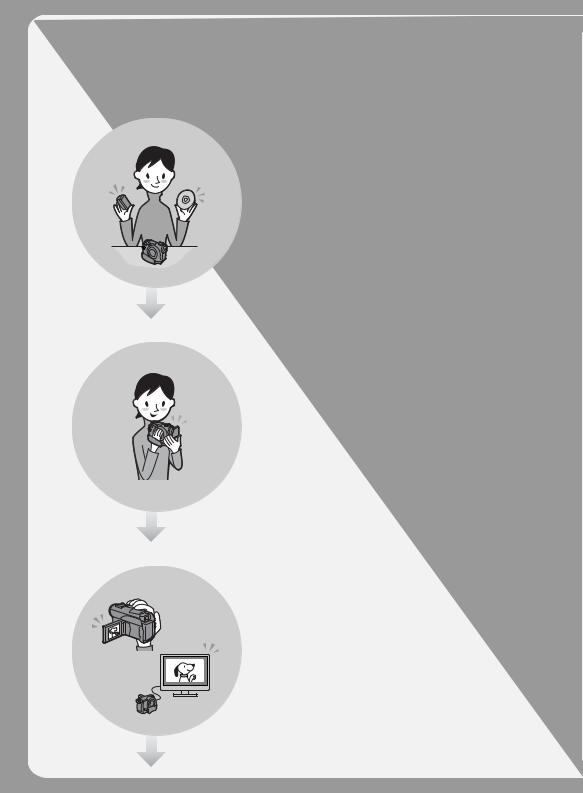
How to prepare and use your DVD Handycam
Preparing
 Prepare a new disc.
Prepare a new disc.
• You can start recording promptly with a DVD-R.
• You need to format a DVD-RW before recording.
Formatting is also required when using a once recorded DVD-RW again.
 Select a recording format (either VIDEO mode or VR mode) when using DVD-RW.
Select a recording format (either VIDEO mode or VR mode) when using DVD-RW.
Shooting
 Both movies and still images can be recorded on a single disc.
Both movies and still images can be recorded on a single disc.
Because your movies and still images are recorded in free areas on the disc automatically, important recordings are not overwritten.
If you finalize the recorded disc after shooting, you can play it back immediately on DVD players, etc..
Playing back
 Select a scene to play back from the Visual
Select a scene to play back from the Visual
Index display.
If you finalize the recorded disc after shooting, you can play it back on DVD players, etc..
Continued on the right page.
8

Editing
 You can make a copy of a disc you have recorded by connecting your DVD Handycam to your computer with the supplied software.
You can make a copy of a disc you have recorded by connecting your DVD Handycam to your computer with the supplied software.
For the recommended computer system environment, see page 91.
 You can produce an original DVD by editing your movies/still images on your computer.
You can produce an original DVD by editing your movies/still images on your computer.
Finalizing
 Finalize the disc so that it becomes compatible with other DVD players.
Finalize the disc so that it becomes compatible with other DVD players.
You may not be able to record additional material, edit, or format a disc after finalizing it, depending on the kind of the disc used.
|
Overwrite |
Edit |
Format |
|
|
|
|
DVD-R |
No |
No |
No |
(VIDEO mode) |
|
|
|
|
|
|
|
DVD-RW |
Yes*1 |
No |
Yes*3 |
(VIDEO mode) |
|
|
|
|
|
|
|
DVD-RW |
Yes*2 |
Yes*2 |
Yes*3 |
(VR mode) |
|
|
|
|
|
|
|
*1 Unfinalizing is required.
*2 Unfinalizing is not required.
*3 Recorded data will be erased.
first this Read
9

Table of contents
Read this first |
|
What you can do with your |
|
DVD Handycam ............................... |
4 |
What is the difference between |
|
DVD-R and DVD-RW? .................... |
6 |
How to prepare and use your DVD |
|
Handycam ......................................... |
8 |
Getting Started |
|
Using this manual ................................. |
12 |
Checking the supplied accessories ..... |
14 |
Step 1 Preparing the power source ... |
15 |
Installing/removing the battery |
|
pack ............................................ |
15 |
Charging the installed |
|
battery pack .............................. |
16 |
Showing the remaining battery time |
|
– BATTERY INFO .................... |
18 |
Connecting to a wall outlet ........... |
18 |
Step 2 Turning on the power .............. |
19 |
Step 3 Adjusting the LCD screen and |
|
the viewfinder ................................. |
20 |
Adjusting the angle and the |
|
brightness of the LCD screen ... |
20 |
Adjusting the viewfinder .............. |
22 |
Step 4 Setting the date and time ........ |
23 |
Simple setting of the clock using a |
|
time difference ......................... |
25 |
Step 5 Preparing a disc for recording . 26 |
|
Shooting movies/still images |
|
Before shooting ...................................... |
28 |
Shooting movies .................................... |
29 |
Selecting the recording mode ....... |
32 |
Using the zoom feature ................. |
33 |
Shooting with the subject checking |
|
the image – Mirror mode ........ |
34 |
Shooting still images ............................. |
35 |
Selecting the still image quality |
|
and size ..................................... |
38 |
Shooting images continuously |
|
(BURST, DCR-DVD201 only) .. |
41 |
Adjusting the exposure ........................ |
43 |
Adjusting the exposure for backlit |
|
subjects – BACK LIGHT ......... |
43 |
Adjusting the exposure |
|
manually ................................... |
43 |
Shooting in the dark – NightShot plus, |
|
etc. ..................................................... |
45 |
Using NightShot plus .................... |
45 |
Using Super NightShot plus ......... |
45 |
Using the NightShot Light ............ |
46 |
Using Color Slow Shutter .............. |
46 |
Self-timer recording .............................. |
47 |
On shooting movies ....................... |
47 |
On shooting still images ................ |
47 |
Shooting for the wide-screen TV |
|
– 16:9 Wide mode ........................... |
48 |
Adjusting the white balance |
|
manually .......................................... |
50 |
Shooting techniques to match your |
|
circumstances – PROGRAM AE ... |
51 |
Focusing manually ................................ |
52 |
Shooting with special effects .............. |
53 |
Using fader (for movies only) ....... |
53 |
Using special effects |
|
– Picture effect/Digital effect ... |
54 |
Checking/Deleting the last scene ....... |
55 |
Checking the last scene |
|
– Review .................................... |
55 |
Deleting the last scene |
|
(DVD-RWs only) ...................... |
55 |
Viewing the recordings |
|
Playing a disc on your camcorder ...... |
56 |
Choosing and viewing a recording |
|
– Visual Index ........................... |
56 |
Various playback modes ............... |
58 |
Displaying the indicators during |
|
playback – Display .................. |
59 |
Magnifying recorded images |
|
– PB ZOOM (Playback zoom) .. |
61 |
Playing still images automatically |
|
– Slide Show ............................ |
62 |
Viewing recordings on TV ................... |
63 |
Finalizing a disc for other |
|
players |
|
Finalizing a disc ..................................... |
64 |
Changing the disc title ................... |
67 |
Playing back a disc on a DVD |
|
player, etc. ................................. |
69 |
Playing back a disc on a computer |
|
with a DVD drive installed .... |
70 |
Recording on a finalized disc |
|
– Unfinalizing (VIDEO mode |
|
DVD-RWs only) .............................. |
72 |
Recording again on a used disc |
|
– Formatting (DVD-RWs only) ..... |
74 |
10

Using a disc in VR mode |
|
(DVD-RWs only) |
|
Selecting the playing order on your |
|
camcorder – Playlist ....................... |
76 |
Registering movies or still images in |
|
the Playlist ................................ |
76 |
Converting all the still images on a |
|
disc to a movie file |
|
– Photomovie ........................... |
79 |
Erasing unnecessary scenes from the |
|
Playlist ....................................... |
80 |
Changing the order within the |
|
Playlist ....................................... |
82 |
Dividing a movie within |
|
the Playlist ................................ |
84 |
Playing the Playlist ......................... |
86 |
Editing the original data ...................... |
87 |
Dividing a movie ............................ |
87 |
Deleting movies/still images ....... |
89 |
Viewing/duplicating discs/ editing the recordings on your computer
Connecting your camcorder to your |
|
computer – Introduction ............... |
91 |
System requirements ..................... |
91 |
Installing the USB driver ............... |
92 |
Installing software .......................... |
93 |
Connecting your camcorder to the |
|
computer ................................... |
94 |
Consulting the on-line help .......... |
98 |
Viewing scenes recorded on your |
|
computer .......................................... |
99 |
Viewing scenes on the disc ........... |
99 |
Making a disc copy |
|
– Disc Duplicating ........................ |
101 |
Making a disc copy ...................... |
101 |
Editing and saving scenes .................. |
102 |
Editing movies .............................. |
102 |
Saving the movie |
|
on your computer .................. |
102 |
Creating an original disc .................... |
103 |
Making a menu ............................. |
103 |
Editing the contents ..................... |
104 |
Recording on a disc ...................... |
105 |
Connecting your camcorder to |
|
a TV and a VCR |
|
Dubbing a disc to a tape ..................... |
106 |
Connecting your camcorder to a |
|
VCR .......................................... |
106 |
Dubbing to a tape ......................... |
107 |
Dubbing a TV program or video tape |
|
onto a disc ...................................... |
108 |
Connecting your camcorder to a TV |
|
or a VCR .................................. |
108 |
Selecting the Video jack to be used |
|
on the TV or the VCR ............ |
108 |
Dubbing onto a disc ..................... |
109 |
Customizing your camcorder |
|
Changing the SETUP display ............ |
110 |
Selecting the option of each item .. |
111 |
Troubleshooting |
|
Types of trouble and corrective |
|
action .............................................. |
118 |
Self-diagnosis display ......................... |
125 |
Warning indicators ............................. |
126 |
Warning messages .............................. |
127 |
Additional information |
|
About the disc ...................................... |
129 |
About the “InfoLITHIUM” |
|
battery pack ................................... |
130 |
Using your camcorder abroad .......... |
131 |
Maintenance information and |
|
precautions .................................... |
132 |
Specifications ....................................... |
135 |
Parts and controls/Index |
|
Identifying parts and controls ........... |
137 |
Index ..................................................... |
145 |
Started Getting
11
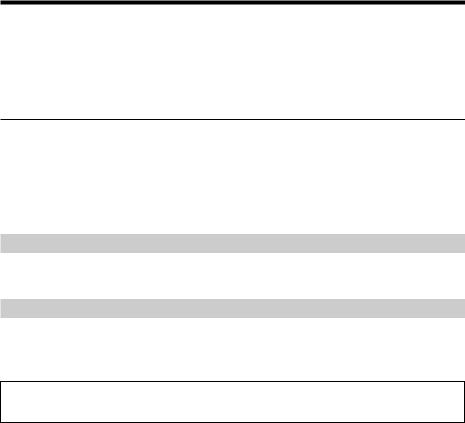
— Getting Started —
Using this manual
The instructions in this manual are for the two models listed in the table below. Before you start reading this manual and operating your camcorder, check the model number by looking at the bottom of your camcorder. The DCR-DVD201 is the model used for illustration purposes. Otherwise, the model name is indicated in the illustrations. Any differences in operation are clearly indicated in the text, for example, “DCR-DVD201 only”.
Types of differences
Model |
DVD101 |
DVD201 |
|
3.0 mm (1/6 type) |
3.6 mm (1/5 type) |
Image device |
CCD, gross approx. |
CCD, gross approx. |
|
680 000 pixels |
1 070 000 pixels |
|
|
|
LCD screen |
6.2 cm (2.5 type) |
6.2 cm (2.5 type) |
Note on TV color systems
TV color systems differ depending on the country or region. To view your recordings on a TV, you need an NTSC system-based TV.
Copyright precautions
Television programs, films, video tapes, and other materials may be copyrighted. Unauthorized recording of such materials may be contrary to copyright laws. You cannot dub copyright protected software on your camcorder.
Contents of the recording cannot be compensated if recording or playback is not made due to a malfunction of the camcorder, storage media, etc.
12

Using this manual
Camcorder care
LCD display/viewfinder
The LCD display and the viewfinder are manufactured using extremely highprecision technology, so over 99.99 % of the pixels are operational for effective use. However, there may be some tiny black points and/or bright points (white, red, blue or green in color) that appear constantly on the LCD display and the viewfinder. These points are normal in the manufacturing process and do not affect the recording in any way.
Disc compatibility with other players
Discs recorded on your camcorder must be finalized to be played on other players. For details on how to finalize a disc, see “Finalizing a disc” (page 64).
Discs recorded in VIDEO mode
You must finalize a disc after all the recording is finished. You cannot record additional scene on a disc recorded in VIDEO mode once you finalize it. On DVD-RW, you can record additional scene by unfinalizing it.
Discs recorded in VR mode
Only DVD-RWs can be recorded in VR mode. Finalizing is required only when other DVD-RW compatible players cannot play the disc. You can record again with your camcorder on a finalized disc recorded in VR mode.
Compatible players: DVD players that can play back DVD-RWs in VR mode.
Note
You may not be able to play certain finalized discs, depending on the disc and the players.
Started Getting
13

Checking the supplied accessories
Make sure that the following accessories are supplied with your camcorder.
1 |
2 |
3 |
4 |
5 |
6 |
7 |
||||
|
|
|
|
|
|
|
|
|
|
|
|
|
|
|
|
|
|
|
|
|
|
|
|
|
|
|
|
|
|
|
|
|
|
|
|
|
|
|
|
8 |
9 |
0 |
1Wireless Remote Commander (1) (page 142)
2AC-L15A/L15B AC adaptor (1),
Power cord (1) (page 16)
3NP-FM50 rechargeable battery pack
(1) (page 15)
4 A/V connecting cable (1)
5 Shoulder strap (1)
6 Lens cap (1) (page 28)
7USB cable (Hi-SPEED USB compatible)
(1) (page 92)
8 DVD-R (DMR30) (1)
9 CD-ROM (SPVD-011 USB Driver) (1) q; Cleaning cloth (1)
14
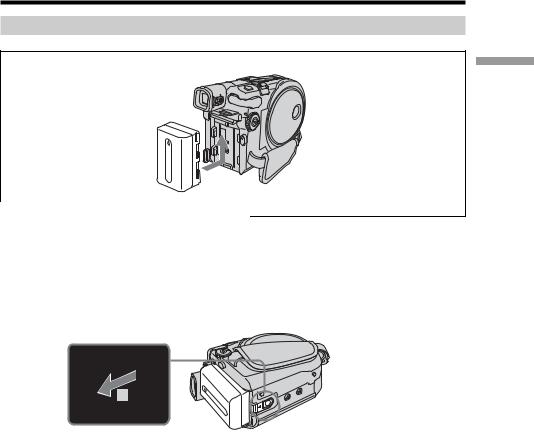
Step 1 Preparing the power source
Installing/removing the battery pack
Started Getting
To install the battery pack, slide it in and up in the direction of the arrow until it clicks.
To remove the battery pack
1
2
Slide the battery pack in the direction of arrow while pressing the battery release button.
Slide the battery pack down.
1
2
BATT release button
15

Step 1 Preparing the power source
Charging the installed battery pack
Your camcorder operates only with the “InfoLITHIUM” battery pack (M series).
See page 130 for more information on the “InfoLITHIUM” battery pack.
Open the DC IN jack cover.
With the v mark on
the DC plug facing up
POWER/CHG lamp 
 2
2
4 Power cord
AC adaptor
1
3
1
2
3
4
Make sure that the battery pack is installed on the camcorder.
Open the DC IN jack cover, then connect the AC adaptor supplied with your camcorder to the DC IN jack on your camcorder with the plug’s vmark facing up.
Connect the power cord to the AC adaptor.
Connect the power cord to the wall outlet.
Charging begins. The POWER/CHG lamp lights in orange during the charge, then turns off when the charge is completed (full charge).
After charging the battery pack
Disconnect the AC adaptor from the DC IN jack on your camcorder.
Notes
•Prevent metallic objects from coming into contact with the metal parts of the DC plug of the AC adaptor. This may cause a short-circuit, damaging the AC adaptor.
•Place the AC adaptor near a wall outlet. If any trouble occurs with this unit while using the AC adaptor, disconnect the plug from the wall outlet as soon as possible to cut off the power.
•The POWER/CHG lamp may flash if the battery pack is not installed correctly or the battery pack is damaged.
16

Step 1 Preparing the power source
Charging time (full charge)*1
Battery pack
NP-FM50 (supplied) |
150 |
NP-QM71/QM71D |
260 |
NP-QM91/QM91D |
360 |
Recording time with the viewfinder*2
Battery pack |
Continuous |
|
|
Typical*3 |
|
DVD101 |
DVD201 |
DVD101 |
DVD201 |
||
|
|||||
|
|
|
|
|
|
NP-FM50 (supplied) |
135 |
115 |
65 |
55 |
|
NP-QM71/QM71D |
325 |
285 |
160 |
140 |
|
NP-QM91/QM91D |
490 |
430 |
245 |
215 |
Recording time with the LCD display*2
LCD BACKLIGHT is set to ON
Battery pack |
Continuous |
|
|
Typical*3 |
|
DVD101 |
DVD201 |
DVD101 |
DVD201 |
||
|
|||||
|
|
|
|
|
|
NP-FM50 (supplied) |
120 |
105 |
60 |
50 |
|
NP-QM71/QM71D |
290 |
265 |
145 |
130 |
|
NP-QM91/QM91D |
445 |
400 |
220 |
200 |
|
LCD BACKLIGHT is set to OFF |
|
|
|
||
Battery pack |
Continuous |
|
|
Typical*3 |
|
DVD101 |
DVD201 |
DVD101 |
DVD201 |
||
|
|||||
|
|
|
|
|
|
NP-FM50 (supplied) |
135 |
120 |
65 |
60 |
|
NP-QM71/QM71D |
335 |
300 |
165 |
150 |
|
NP-QM91/QM91D |
505 |
455 |
250 |
225 |
|
Playing time*2 |
|
|
|
|
|
Battery pack |
Playing time on LCD screen |
Playing time with LCD closed |
|||
DVD101 |
DVD201 |
DVD101 |
DVD201 |
||
|
|||||
|
|
|
|
|
|
NP-FM50 (supplied) |
130 |
115 |
140 |
125 |
|
NP-QM71/QM71D |
315 |
285 |
340 |
305 |
|
NP-QM91/QM91D |
475 |
430 |
520 |
465 |
|
*1 Approximate number of minutes required at 25°C (77°F) to charge an empty battery pack. The charging time may increase if the battery’s temperature is extremely high or low because of the ambient temperature.
*2 Approximate number of minutes you can record when using a fully charged battery pack.
*3 Approximate number of minutes you can record, including starting/stopping, zooming, and turning the power on/off. The actual battery life may be shorter.
Notes
•If the power goes off even though the remaining battery time indicator indicates that the battery pack has enough power to operate, charge the battery pack fully again so that the indication on the remaining battery time indicator is correct.
•Battery pack performance decreases in low-temperature surroundings and recording may not be possible even though the battery time remaining may be as much as 20 minutes. Recharge the battery pack fully in this case.
•NP-FM30 is not recommended because of its short recording time when used with
your camcorder.
Started Getting
17
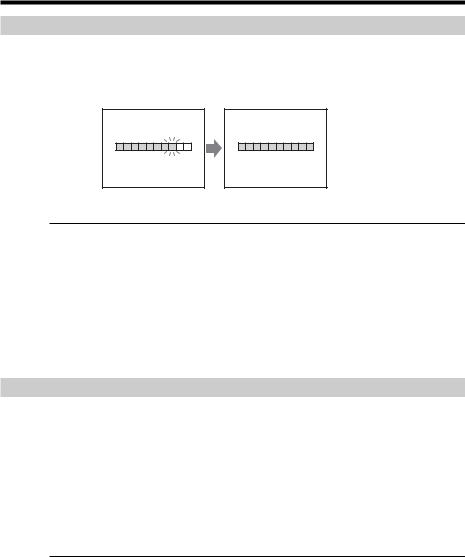
Step 1 Preparing the power source
Showing the remaining battery time – BATTERY INFO
1
2
Open the LCD screen.
Press DISPLAY/BATT INFO.
The remaining battery time appears for a while on the LCD display.
BATTERY INFO
BATTERY CHARGE LEVEL 0% 50% 100%
REC TIME AVAILABLE LCD SCREEN : 96 min VIEWFINDER : 108 min
BATTERY INFO
BATTERY CHARGE LEVEL 0% 50% 100%
REC TIME AVAILABLE LCD SCREEN : 120 min VIEWFINDER : 135 min
During charging |
Fully charged |
Notes
•BATTERY INFO does not appear when the power of the camcorder is ON.
•The remaining battery time may not be indicated in the following cases:
–The battery pack is not installed correctly.
–The battery pack is damaged.
–The battery pack is empty.
•The number displayed as Battery Info is the approximate recording time.
•While the remaining battery time is being calculated, “CALCULATING BATTERY INFO...” is displayed.
•It may take some time to display the remaining battery time after DISPLAY/BATT INFO is pressed.
Connecting to a wall outlet
When you use your camcorder for a long time, it is recommended that you power it from a wall outlet using the AC adaptor.
1 Open the DC IN jack cover, then connect the AC adaptor supplied with your camcorder to the DC IN jack on your camcorder with the plug’s vmark facing up.
2 Connect the power cord to the AC adaptor.
3 Connect the power cord to a wall outlet. See page 16 for details.
Notes
•The AC adaptor can supply power even if the battery pack is attached to your camcorder.
•The DC IN jack has “source priority”. This means that the battery pack cannot supply any power if the AC adaptor is connected to the DC IN jack, even when the power cord is not plugged into a wall outlet.
•Your camcorder is not disconnected from the AC power source (house current) as long as it is connected to the wall outlet, even if your camcorder itself has been turned off.
18
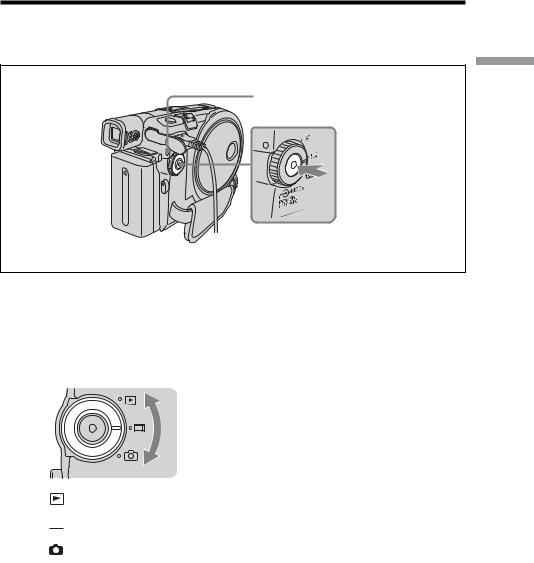
Step 2 Turning on the power
Press the POWER button for a few seconds. Your camcorder turns on and the POWER/ CHG lamp lights up in green. When you turn on your camcorder for the first time, the CLOCK SET display appears.
POWER/CHG lamp
To turn the power off
Press the POWER button for a few seconds again. When the POWER/CHG lamp turns off, the power cuts off.
To set the mode dial
Rotate and set the mode dial to the operation you want to perform, such as shooting or playback.
: Playback/edit
Select this when you play back or edit the recorded scenes on your camcorder. 


 : Movies
: Movies
Select this when you shoot the movies. : Still images
Select this when you shoot the still images.
Started Getting
19

Step 3 Adjusting the LCD screen and the viewfinder
Adjusting the angle and the brightness of the LCD screen
Adjust the brightness and the angle of the LCD screen properly in your sight.
2
180°
90°
LCD BACKLIGHT 
button
90°
1
1
2
Open the LCD screen.
Adjust the direction of the LCD screen to the desired position.
When you adjust the angle of the LCD screen, make sure if the LCD screen is opened up to a full 90 degrees.
You can turn the LCD screen over and then fold it back to the camcorder body with the LCD screen facing out as shown below.
To adjust the brightness of the LCD display
1
2
Turn the power on by pressing the POWER button for a few seconds.
Press SETUP.
The SETUP display appears.
MANUAL SET
PROGRAM AE
P EFFECT
D EFFECT
WHT BAL
AUTO SHTR
[ SETUP ] : END
3 Use the multi-selector to select  (LCD/VF SET). Refer to page 23 to see how to use the multi-selector.
(LCD/VF SET). Refer to page 23 to see how to use the multi-selector.
LCD / VF SET
LCD BRIGHT
LCD B. L.


 LCD COLOR
LCD COLOR
VF B. L.
 RETURN
RETURN
[ SETUP ] : END
20
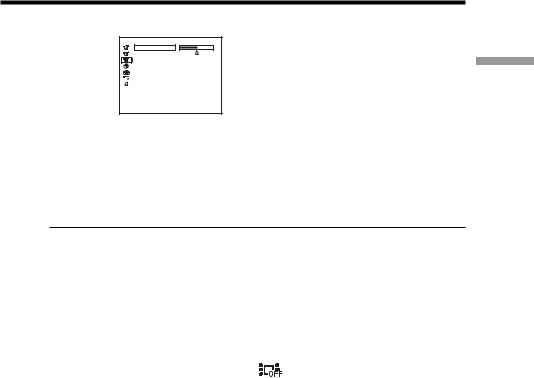
Step 3 Adjusting the LCD screen and the viewfinder
4 Use the multi-selector to select [LCD BRIGHT].
LCD / VF SET |
LCD BRIGHT |
[ SETUP ] : END |
5 Use the multi-selector to adjust the brightness of the LCD display. − : Get Darker
+ : Get Brighter
The LCD screen brightness is adjusted.
6 Press SETUP.
The SETUP display disappears from the LCD display.
Note
[LCD B.L.] is set to [BRT NORMAL] when you close the LCD screen facing out.
Tips
•You can change the brightness of the backlight. Select  (LCD/VF SET) then [LCD B.L.] in the SETUP display when using the battery pack (page 113).
(LCD/VF SET) then [LCD B.L.] in the SETUP display when using the battery pack (page 113).
•The [LCD BRIGHT], [LCD B.L.] and [LCD COLOR] settings do not affect the brightness of the image when you are recording.
•The backlight of the LCD screen is set to ON normally. When you use the camcorder outdoors, set it to OFF so that the battery pack lasts longer.
•When you turn off the LCD back light, the |
icon appears on the LCD display. |
Started Getting
21
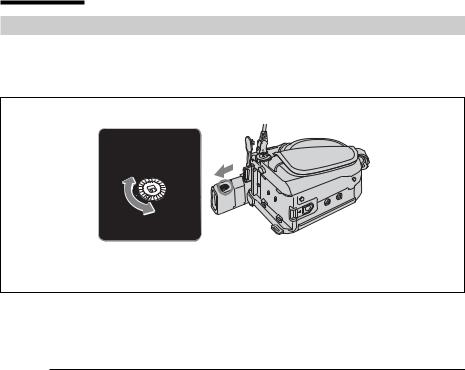
Step 3 Adjusting the LCD screen and the viewfinder
Adjusting the viewfinder
When recording pictures with the LCD screen closed, check the picture with the viewfinder. Adjust the viewfinder lens to accommodate your eyesight so that the image in the viewfinder comes into sharp focus.
2
1
Viewfinder lens adjustment dial
1 Extend the viewfinder.
2 Turn the viewfinder lens adjustment dial until you can see the characters in the viewfinder clearly.
Tips
•If you install a large capacity battery pack such as the NP-QM91/QM91D in your camcorder, extend the viewfinder and adjust the angle.
•You can change the brightness of the viewfinder backlight. Select [VF B.L.] in the SETUP display when using the battery pack (page 113).
•The [VF B.L.] setting does not affect the brightness of the image when you are recording.
•Recording pictures with the viewfinder is recommended in the following cases:
–When the pictures on the LCD screen are hard to see.
–When you want to save on battery consumption.
22

Step 4 Setting the date and time
Set the date and time when you use your camcorder for the first time. Set the geographical area, then daylight savings time([DST]), the year, the month, the day, the hour and the minute, in that order. If you do not set the date and time, the [CLOCK SET] display appears whenever you turn on your camcorder or change the mode dial. If you do not use your camcorder for about 3 months, the date and time settings may be cleared from memory because the built-in rechargeable battery in your camcorder will have been discharged during that time. In that case, charge the built-in rechargeable battery by connecting the AC adaptor, and set the date and time again (page 16, 134).
FAR

 NEAR
NEAR
|
Multi-selector: |
|
|
Select with V/v/B/b and |
|
|
press the button in the |
|
SETUP button |
center to confirm your |
|
selection. |
||
|
1 Open the LCD screen.
2 Turn the power on by pressing the POWER button for a few seconds. The CLOCK SET display appears.
CLOCK SET |
|
|
|
|
AREA 26 |
|
GMT |
-5.0 |
|
|
New York,Bogota |
|
||
DST |
OFF |
|
|
|
DATE |
Y |
M |
D |
: |
|
|
|
|
|
[ ENTER ] : NEXT ITEM |
|
|||
3 Use the multi-selector to select the desired geographical area.
CLOCK SET
AREA 26 GMT -5.0
New York,Bogota
DST OFF ON
DATE Y M D
:
[ ENTER ] : NEXT ITEM
Started Getting
23

Step 4 Setting the date and time
4 Use the multi-selector to set daylight savings time ([DST]) to [ON], if necessary.
CLOCK SET
AREA 26 GMT -5.0
New York,Bogota
DST OFF
DATE  Y
Y  M
M  D
D
2004 JAN 1 12 : 00AM
[ ENTER ] : NEXT ITEM
5 Use the multi-selector to set the year.
CLOCK SET
AREA 26 GMT -5.0
New York,Bogota
DST OFF
DATE  Y
Y  M
M  D
D
2004 JAN 1 12 : 00AM
[ ENTER ] : NEXT ITEM
6 Set the month, day, hour and minute with the same procedure as in step 5, and then press the button in the center.
The clock starts to move.
The internal clock of your camcorder operates on a 12-hour cycle.
•12:00 AM stands for midnight.
•12:00 PM stands for noon.
Tips
•If the CLOCK SET display does not appear in step 2, press SETUP, then select  (SETUP MENU), then [CLOCK SET] using the multi-selector.
(SETUP MENU), then [CLOCK SET] using the multi-selector.
•If the SETUP display appears after step 6, press SETUP. The SETUP display disappears.
24

Step 4 Setting the date and time
Simple setting of the clock using a time difference
You can easily set the clock to the local time by setting the area. In the SETUP display use the multi-selector to select  (OTHERS) then [AREA SET] .
(OTHERS) then [AREA SET] .
World time difference
|
|
|
|
|
|
|
|
|
|
|
|
|
|
|
|
|
|
|
|
|
|
|
|
|
|
|
|
|
|
|
|
|
|
|
|
|
|
|
|
|
|
|
|
|
|
|
|
|
|
|
|
|
|
|
|
|
|
|
|
|
|
|
|
|
|
|
|
|
|
|
|
|
|
|
|
|
|
|
|
|
|
|
|
|
|
|
|
|
|
1 |
2 |
3 |
4 |
6 |
8 10 12 13 14 16 17 18 19 20 21 22 23 24 25 26 27 29 30 31 |
||||||||||||||||||||||||
Started Getting
Area |
Time-zone |
Area setting |
|
code |
differences |
||
|
|||
1 |
GMT |
Lisbon, London |
|
2 |
+01:00 |
Berlin, Paris |
|
3 |
+02:00 |
Helsinki, Cairo |
|
4 |
+03:00 |
Moscow, Nairobi |
|
5 |
+03:30 |
Tehran |
|
6 |
+04:00 |
Abu Dhabi, Baku |
|
7 |
+04:30 |
Kabul |
|
8 |
+05:00 |
Karachi, Islamabad |
|
9 |
+05:30 |
Calcutta, New Delhi |
|
10 |
+06:00 |
Almaty, Dhaka |
|
11 |
+06:30 |
Rangoon |
|
12 |
+07:00 |
Bangkok, Jakarta |
|
13 |
+08:00 |
HongKong, Singapore |
|
14 |
+09:00 |
Seoul, Tokyo |
|
15 |
+09:30 |
Adelaide, Darwin |
|
16 |
+10:00 |
Melbourne, Sydney |
|
|
|
|
Area |
Time-zone |
Area setting |
|
code |
differences |
||
|
|||
|
|
|
|
17 |
+11:00 |
Solomon Is. |
|
18 |
+12:00 |
Fiji, Wellington |
|
19 |
–12:00 |
Eniwetok, Kwajalein |
|
20 |
–11:00 |
Midway Is., Samoa |
|
21 |
–10:00 |
Hawaii |
|
22 |
–09:00 |
Alaska |
|
23 |
–08:00 |
LosAngeles, Tijuana |
|
24 |
–07:00 |
Denver, Arizona |
|
25 |
–06:00 |
Chicago, Mexico City |
|
26 |
–05:00 |
New York, Bogota |
|
27 |
–04:00 |
Santiago |
|
28 |
–03:30 |
St. John’s |
|
29 |
–03:00 |
Brasilia, Montevideo |
|
30 |
–02:00 |
Fernando de Noronha |
|
31 |
–01:00 |
Azores |
25

Step 5 Preparing a disc for recording
A new DVD-R or DVD-RW is required for recording. You cannot overwrite or delete data recorded on a DVD-R, but you can delete data and record again with a DVD-RW. The preparation procedure is different depending on the type of disc you use.
Notes
•When you insert or remove a disc, move the grip belt to the bottom of the camcorder so as not to obstruct the operation with your hand, etc..
•Do not apply shock or vibration to your camcorder while [DISC ACCESS] or [PREPARING TO OPEN COVER] is displayed on the LCD display.
•Formatting is required when a DVD-RW is used for the first time.
1 |
3 |
2 |
|
5 |
4 |
Make sure that the disc is not exposed to fingerprints and dust.
1
2
3
Set the mode dial to 

 (Movie) or
(Movie) or  (Still).
(Still).
Turn the power on by pressing the POWER button for a few seconds.
Slide the disc cover OPEN switch in the direction of the arrow mark. Opening melody rings once, then the camcorder beeps intermittently. [PREPARING TO OPEN COVER] appears on the LCD display. After the beep sound stops, the disc cover opens automatically.
 ACCESS lamp
ACCESS lamp
4 Set the disc with the label side facing out, then press firmly to seat it on the center spindle until it clicks.
26

Step 5 Preparing a disc for recording
5 Close the disc cover.
Your camcorder starts recognizing the inserted disc.
With a DVD-R, you can start recording immediately after [DISC ACCESS] disappears on the LCD display.
The FORMAT display appears when you insert a DVD-RW. Proceed to step 6.
FORMAT
REC FORMAT VIDEO
EXECUTE
EST. PROCESS TIME : 7sec
REC FORMAT : VIDEO
6 Use the multi-selector to select [REC FORMAT].
7 Use the multi-selector to select desired recording format.
Your camcorder is set in VIDEO mode as the default setting. Refer to page 7 about recording mode.
8 Use the multi-selector to select [EXECUTE].
9 Use the multi-selector to select [YES].
The selection of the recording format is completed.
The disc formatting starts. When the formatting is completed, you can start recording on the DVD-RW.
Notes
•It may take some time to recognize the disc depending on the disc type and condition.
•If you close the disc cover with the disc set incorrectly, it may cause your camcorder to malfunction.
•You may hear the motor running when the disc cover is closed without a disc being set. This is not a malfunction.
•Do not remove the battery pack or disconnect the AC adaptor while formatting.
•You can remove the disc when a power source is connected to your camcorder even when your camcorder is turned off. However, when you change the disc, the disc recognition process does not start automatically.
To remove the disc
1 Perform the step 3 on page 26.
2 Remove the disc.
Tips
•When you replace a disc, disc information such as the date you started to use it and information on previously recorded areas appears for about 5 seconds. The information on previously recorded areas may not be displayed correctly depending on the condition of the disc.
•See page 129 for details on disc handling.
Started Getting
27
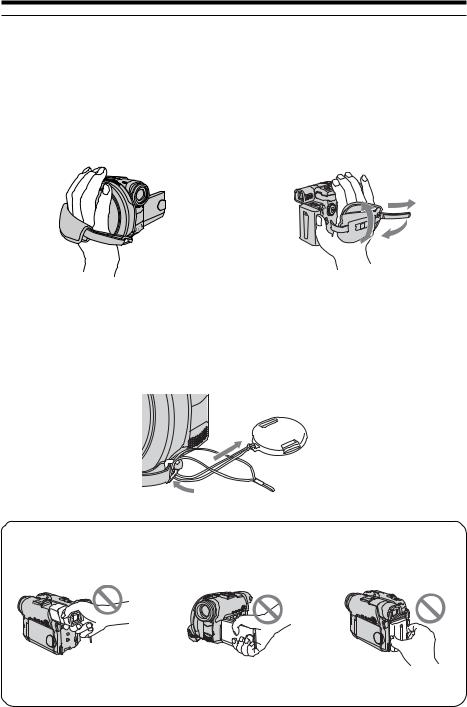
— Shooting movies/still images —
Before shooting
Note
To shoot movies/still images correctly, note the following:
–Hold your camcorder correctly.
–Do not shock or vibrate your camcorder during shooting.
–Do not scratch, put the fingerprint on, or get the disc dirty.
To hold your camcorder
Hold your camcorder with your fingers inserted through the grip belt.
To fasten the grip belt
Fasten the grip belt firmly following the illustration below.
1 2

 3 4
3 4
To attach the lens cap
Attach the lens cap to the metal fittings of the grip belt, as illustrated below, using the strap.
Note
Do not pick up your camcorder by the viewfinder, the LCD screen, or the battery pack.
Viewfinder |
LCD screen |
Battery pack |
28
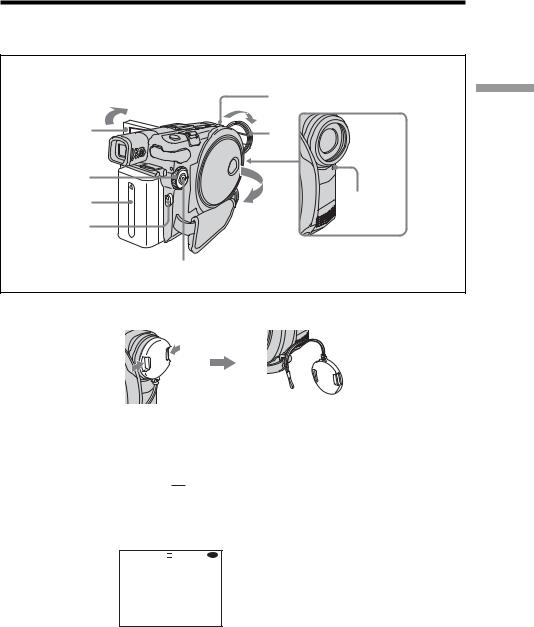
Shooting movies
Perform “Getting Started” from step 1 to 5 beforehand (page 15).
The following operation is common with VIDEO mode and VR mode.
|
6 |
|
3 |
1 |
|
4 |
|
|
2 |
Recording |
|
lamp |
||
7 |
||
|
5
1 Remove the lens cap by pressing both knobs on the sides of the cap.
2 Install the battery pack or connect the AC adaptor (page 15).
3 Open the LCD screen.
The image is not displayed in the viewfinder when the LCD screen opens.
4 Set the mode dial to 


 (Movie).
(Movie).
5 Turn the power on by pressing the POWER button for a few seconds.
6 Insert a disc (page 26).
This sets your camcorder to standby.
 STBY0:00:00 -R
STBY0:00:00 -R
VIDEO
images movies/still Shooting
29
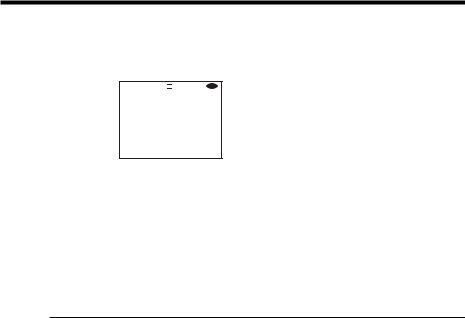
Shooting movies
7 Press START/STOP (z).
Your camcorder starts recording. [REC] appears on the LCD display. The camera recording lamp located on the front of your camcorder lights up. To stop recording, press START/STOP again.
 REC 0:00:01 -R
REC 0:00:01 -R
VIDEO
You can operate start/stop with the REC START/STOP button on the LCD screen. This is useful when you shoot movies from a low angle.
After recording
1
2
3
4
Remove the disc (page 27).
Turn the power off by pressing the POWER button for a few seconds again. Close the LCD screen.
Remove the battery pack or disconnect the AC adaptor.
Notes
•Make sure that the lens cap strap is not caught into the disc cover when you insert or remove a disc.
•Do not touch the built-in microphone during recording.
•When the ACCESS lamp lights on, data is being recorded on the disc. Take note of the following when data is being recorded, or the data or the disc may be damaged.
–Do not apply shock or shake the camcorder.
–Do not turn the power off.
–Do not remove the battery pack or disconnect the AC adaptor.
–Do not open the disc cover.
•The writing time to the disc for recording may vary depending on the recording mode (page 32).
•There may be time difference between the point when you press START/STOP and the actual point that the recording starts/stops.
•Make sure the POWER/CHG lamp is off when you remove the power source.
Tip
If you leave your camcorder powered by the battery pack for five minutes, your camcorder automatically turns off. This is to save battery power and to prevent battery wear. Turn the power on again by pressing the POWER button for a few seconds. You can cancel the automatic power-off by setting the  (SETUP MENU) – [A. SHUT OFF] menu item to [NEVER] in the SETUP display.
(SETUP MENU) – [A. SHUT OFF] menu item to [NEVER] in the SETUP display.
30
